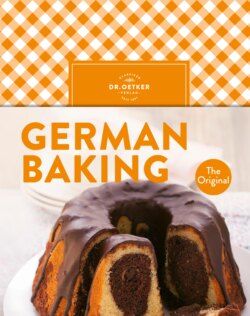Читать книгу German Baking - Dr. Oetker - Страница 5
На сайте Литреса книга снята с продажи.
General advice about the book
ОглавлениеTo ensure that the cakes, pastries and puddings you make taste as delicious and look as irresistibly mouthwatering as you imagine them, here are a few tips before you start cooking:
Preparation
Read the recipe through carefully before you start your preparations – in fact, read it before you go shopping to buy the ingredients. Many things will become much clearer when you understand the links between the various steps. Gather together all the ingredients, the appropriate tin or mould and the kitchen and baking utensils that you will need before you begin.
Estimating the degree of difficulty
Some recipes are fairly simple while others require a little more practice and experience. If you are not quite sure and are receiving guests, it is better to try out the recipe first.
Conversions and equivalents
The conversions and equivalents are valid for all recipes and listed on the inside pages of the cover will help you measure the correct quantities for your ingredients.
Preparation time
The preparation time indicated in the recipe is only given as a guideline – it is a rough estimate and will depend on your baking experience. The preparation time only refers to the actual time needed to prepare the ingredients for baking. Cooling times and the time dough takes to rise are only included in the preparation time if they take place at the same time as other preparation activities. The baking time is indicated separately.
Baking tins and moulds
All the recipes in this book use the baking tins or moulds listed below, which are all available in the shops):
•Baking sheet (40 x 30 cm/ 16 x 12 in), also with a high rim
•Muffin mould for 12 muffins
•Tart tin (diameter 26-28 cm/ 10¼-11 in)
•Bundt pan or kugelhopf mould (diameter 22 cm/9 in)
•Ring mould (diameter
22 cm/9 in)
•Rectangular cake tin (25 x 11 cm/ 10 x 4½ in)
•Bread tin (30 x 11 cm/12 x 4½ in)
•Fruit flan mould (diameter 28 cm/ 11 in)
•Springform tin (diameter 26 cm/ 10¼ in) with interchangeable flat bases and a base with a tube in the middle for making a ring cake.
Baking tins and moulds are available in various materials.
Tin moulds are good for gas ovens but are not acid-resistant. Therefore it is advisable to line the inside of a springform mould with baking parchment paper if it is used as a pie ring for fruit pies.
Black moulds are very traditional and particularly good for use in electric and fan ovens. These moulds have excellent non-stick properties and heat conductivity; they are also resistant to fruit acids and easy to clean.
Both tin moulds and black moulds are also available with a non-stick coating which makes it much easier to remove the cake from the mould.
Enamel baking tins have an enamel finish which also acts as a scratch-resistant non-stick coating. They are very long-lasting and resistant to fruit acids. They give the cake an intense, even brown colour.
In addition, tins and moulds are also made of aluminium, ceramic, glass and silicon, all of which are suitable for use in any type of oven.
Baking temperature and baking times
The baking temperatures and baking times indicated in the recipes are given as a guide and they may be increased or reduced depending on the heating performance of the oven being used.
We recommend that you always preheat the oven fully and only put the cake in the oven when it has reached the temperature indicated in the recipe.
To make sure that the cake is done, use the checking test when the baking time indicated has elapsed
Checking if it is done
Sponge and all-in-one sponge: At the end of the baking time indicated in the recipe, stick a wooden skewer deep into the thickest part of the cake, then remove it again. If the skewer comes out dry, without any sponge sticking to it, the cake is done.
Fatless sponge: This is done when it is no longer moist to the touch but feels soft, and when no impression is left on the surface by a finger pressing it lightly.
Biscuits: These are done when they look golden yellow or golden brown.
Yeast dough and quark & oil dough: Lift up a corner of the pastry or cake with a widebladed knife. If the underside is lightly brown and dry, it is done.
Nutritional values
These values have been rounded and refer to a single piece or the total amount, as indicated in the recipe.
Information
At the beginning of most chapters dealing with the various kinds of sponge, dough and pastry, you will find an information section with general explanations, helpful tips and advice about the preparations of the recipes.
You will also find general information about a wide range of subjects related to baking: ovens, height of the oven shelves, kitchen utensils and baking accessories, baking ingredients, garnishing and decorating, as well as glossary of baking terms.
In addition, after each recipe you will find numerous tips as well as suggested recipe variations, modifications and explanations.
Maintain hygiene standards
All kitchen utensils should be clean and function perfectly. It is better to replace scratched cutting boards. Clean the fridge, oven and baking tins and moulds regularly.
From the moment they are purchased to the day the dishes are prepared, all food items must be transported, stored and prepared in an appropriate way.
Regularly wash hands, wear clean clothes and, if you cut yourself, wear kitchen gloves or use waterproof plasters.
Regularly clean your kitchen workspace, dispose of your waste, change dishcloths and tea towels several times a week.
